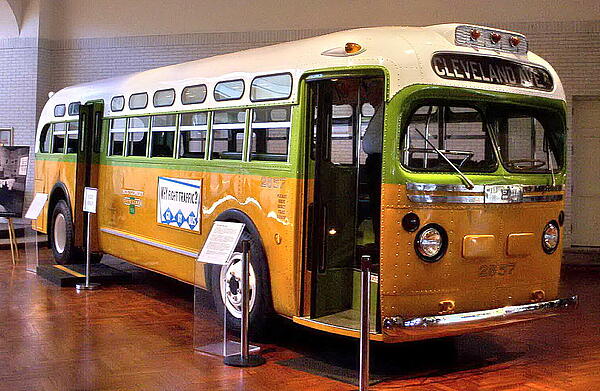Montgomery Bus Boycott
The Montgomery Bus Boycott was triggered by the arrest of Rosa Parks for refusing to give up her seat to a white passenger. The 13-month protest led to the US Supreme Court ruling that segregation on buses is unconstitutional. The boycott saw Martin Luther King rise a civil rights leader for his work with the Montgomery Improvement Association.
Segregation in public places had been a characteristic of the South since the end of Reconstruction. The policy of “separate but equal” segregated white and black Americans in restaurants, on buses and in schools. In Montgomery, Alabama, buses were segregated, with the ‘black seats’ located at the back of the bus.
This segregation was challenged on 1 December 1955 by Rosa Parks. Rosa caught the bus after a day’s work as a seamstress. The seats reserved for white Americans were full, leaving one man standing. The bus driver demanded that Rosa, as well as the other women in her row, give up their seats for the white man. Rosa refused to do so. The police were called and she was arrested.

In protest of this injustice, a boycott of the buses by African Americans in Montgomery began. The boycott proved highly successful. Without the custom of the black community the bus company of Montgomery faced bankruptcy.
Many have argued that a bus boycott had been planned for some time before Rosa Parks’ arrest. As early as 1954, 25 local associations in Montgomery had informed the mayor that a city-wide boycott was being planned. The city’s Women’s Political Council had already made plans to challenge Jim Crow practices on buses in 1955.
Rosa Park’s challenge to this racial injustice was not unprecedented. On 2 March 1955 a 15-year-old student, Claudette Colvin, was arrested for refusing to give up her ‘white’ seat. Seven months later, 18-year-old Mary Louise Smith was arrested for refusing to give her seat to a white passenger. These arrests did not gain the same publicity as Rosa Parks’.
Rosa Parks had been a life-long worker for the NAACP and she had taken a special interest in the Claudette Colvin case. At the time of her arrest, Parks had just finished a course on race relations in Monteagle, Tennessee. Although Rosa Parks was educated, she could only find work as a seamstress in the discriminative South.
When Parks was arrested, the NAACP asked the police why they had done this. E D Nixon of the NAACP was told that “it was none of your damn business”. After finding out the reason for her arrest, Nixon posted the bond required for her release. The NAACP asked Parks if they could pursue her case with regards to the legality of segregation.
A one-day boycott of the city’s buses was organised for Monday 5 December. It was greeted with wide support by the African American community.
Martin Luther King was elected president of the Montgomery Improvement Association, which was created in response to the one-day boycott. It extended the boycott following a tide of support from Montgomery’s black community.
In an attempt to put an end to boycott, City officials worked to undermine it. Black cab drivers had charged the same as the buses in an effort to help people get into work. In response to this, city officials made increased the minimum fare a cab driver could charge to 45 cents - this made it illegal to reduce the rate for black commuters.
MIA found a way of getting round this. It created a private taxi plan whereby black car owners picked up people at designated stops.
When MIA met with officials from the bus company, they got nothing.
The white community attempted to use the media to convince the black communities to use the buses by printing stories claiming a resolution to the boycott.
White opposition took many forms. On 30 January 1956, King’s home was bombed. Men driving the private taxi cabs were frequently arrested for the most minor of traffic violations. Insurance firms withdrew their insurance for the vehicles. King only got round this by getting insurance underwritten by Lloyd’s of London. On 21 February, King along with 88 other people was arrested for organising a boycott which violated an obscure law. He was ordered to pay $500 as a fine with $500 costs.
Shops were badly hit in Montgomery as the boycott meant less blacks were shopping in the city centre. Although many shopkeepers opposed integration, their businesses would suffer if they let the boycott continue.
On 5 June 1956, the federal district court ruled in Browder v. Gayle that bus segregation was unconstitutional, and in November 1956 the U.S. Supreme Court affirmed Browder v. Gayle and struck down laws requiring segregated seating on public buses.
The boycott ended on 21 December 1956, with the return of black passengers. However, violence did erupt through the transport system, although it was incited by the white community. Buses were shot at, churches bombed and a bomb was left on the porch of King’s home.
The boycott is considered one of the first major success of the Civil Rights Movement. It showed that is the black community organised themselves and used nonviolent protest, they could become a powerful force. On 10 and 11 January 1956, ministers in MIA met in Atlanta other ministers who worked in the South. The Southern Christian Leadership Conference (SCLC) was born out of this meeting and it elected Martin Luther King as its president.
See also: Rosa Parks
MLA Citation/Reference
"Montgomery Bus Boycott". HistoryLearning.com. 2026. Web.
